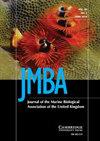沿巴塔哥尼亚大陆架(阿根廷南部)的捕食性钻探对软体动物群的影响
IF 0.9
4区 生物学
Q3 MARINE & FRESHWATER BIOLOGY
Journal of the Marine Biological Association of the United Kingdom
Pub Date : 2024-03-22
DOI:10.1017/s0025315424000249
引用次数: 0
摘要
现今和化石软体动物群落为更好地了解现代和过去底栖生物群落的结构和组织提供了机会。在这一框架内,钻孔被广泛用于探索捕食者与被捕食者之间的相互作用。本研究的重点是阿根廷大陆架巴塔哥尼亚地区现代软体动物群落中记录的捕食痕迹,尤其是钻孔。贝壳类软体动物(n = 2179)是从水深 27 米至 135 米、纬度较长(南纬 39 度至 54 度之间)的水域中采集的。确定了每个站点的分类位置、生态组成和分类群的相对丰度,然后计算了钻探频率(DF),以推断钻探强度。采集到的软体动物隶属于 37 个科,其中以维纳科的标本数量最多(n = 419)。有钻孔的标本(n = 226)属于 21 科(至少有 33 个不同种类)。其中大部分为悬浮取食者(85.8%),其余为其他营养类型。作为主要的潜在捕食者,腹足类和啮齿类共占软体动物群中腹足类的 19.6%。所有观测站的 DF 值为中等(9.9%),但在低(0-2.4%)和高(28.9%)之间变化。这些结果并没有显示出与纬度或深度相关的趋势,而且各站之间 DF 的巨大差异表明,在较小的空间尺度上,当地的其他生态或环境条件也会对钻孔捕食产生影响。本文章由计算机程序翻译,如有差异,请以英文原文为准。
Predatory drilling on molluscan assemblages along the Patagonian shelf (southern Argentina)
Both present-day and fossil molluscan assemblages offer an opportunity for a better understanding of the structure and organization of both modern and past benthic communities. In this framework, drill holes are used widely to explore predator–prey interactions. This research focuses on predation marks, especially drill holes, recorded on modern molluscan assemblages in a Patagonian sector of the Argentinean continental shelf. Shelled molluscs (n = 2179) were recovered from 27 to 135 m depths covering a long latitudinal extent (between 39° and 54°S). For each station, taxonomic position, ecological composition and relative abundance of taxa were determined, and then drilling frequency (DF) was calculated to infer drilling intensity. The collected molluscs belong to 37 families, with Veneridae being the most abundant in terms of the number of specimens (n = 419). Specimens with drill holes (n = 226) belong to 21 families (with at least 33 different species). Most of them are suspension feeders (85.8%) and the remaining percentage comprised other trophic types. Naticids and muricids, as main potential predators, together account for 19.6% of the gastropods present in the molluscan assemblages. DF across all the stations was moderate (9.9%) but varied between low (0–2.4%) and high (28.9%). These results do not show a trend linked to latitude or depth, and the great variability of DF between stations suggests that other local ecological or environmental conditions would influence drilling predation at a small spatio-scale.
求助全文
通过发布文献求助,成功后即可免费获取论文全文。
去求助
来源期刊
CiteScore
2.30
自引率
8.30%
发文量
68
审稿时长
3-8 weeks
期刊介绍:
JMBA is an international journal, publishing original research on all aspects of marine biology. It includes pioneering work taking place today on major issues concerning marine organisms and their environment. Subjects covered include: ecological surveys and population studies of marine communities; physiology and experimental biology; taxonomy, morphology and life history of marine animals and plants; and chemical and physical oceanographic work. Included with 2010 online subscriptions: Marine Biodiversity Records.

 求助内容:
求助内容: 应助结果提醒方式:
应助结果提醒方式:


